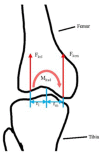Modeling and Simulation of a Human Knee Exoskeleton's Assistive Strategies and Interaction
- PMID: 33762922
- PMCID: PMC7982590
- DOI: 10.3389/fnbot.2021.620928
Modeling and Simulation of a Human Knee Exoskeleton's Assistive Strategies and Interaction
Abstract
Exoskeletons are increasingly used in rehabilitation and daily life in patients with motor disorders after neurological injuries. In this paper, a realistic human knee exoskeleton model based on a physical system was generated, a human-machine system was created in a musculoskeletal modeling software, and human-machine interactions based on different assistive strategies were simulated. The developed human-machine system makes it possible to compute torques, muscle impulse, contact forces, and interactive forces involved in simulated movements. Assistive strategies modeled as a rotational actuator, a simple pendulum model, and a damped pendulum model were applied to the knee exoskeleton during simulated normal and fast gait. We found that the rotational actuator-based assistive controller could reduce the user's required physiological knee extensor torque and muscle impulse by a small amount, which suggests that joint rotational direction should be considered when developing an assistive strategy. Compared to the simple pendulum model, the damped pendulum model based controller made little difference during swing, but further decreased the user's required knee flexor torque during late stance. The trade-off that we identified between interaction forces and physiological torque, of which muscle impulse is the main contributor, should be considered when designing controllers for a physical exoskeleton system. Detailed information at joint and muscle levels provided in this human-machine system can contribute to the controller design optimization of assistive exoskeletons for rehabilitation and movement assistance.
Keywords: anybody; conditional contact elements; damping factor; human-exoskeleton interaction; interactive forces.
Copyright © 2021 Zhang, Liu, Wang, Smith and Gutierrez-Farewik.
Conflict of interest statement
The authors declare that the research was conducted in the absence of any commercial or financial relationships that could be construed as a potential conflict of interest.
Figures







Similar articles
-
Human-in-the-Loop Optimization of Knee Exoskeleton Assistance for Minimizing User's Metabolic and Muscular Effort.Sensors (Basel). 2024 May 22;24(11):3305. doi: 10.3390/s24113305. Sensors (Basel). 2024. PMID: 38894101 Free PMC article.
-
Neuromusculoskeletal model-informed machine learning-based control of a knee exoskeleton with uncertainties quantification.Front Neurosci. 2023 Aug 30;17:1254088. doi: 10.3389/fnins.2023.1254088. eCollection 2023. Front Neurosci. 2023. PMID: 37712095 Free PMC article.
-
Model-based control for exoskeletons with series elastic actuators evaluated on sit-to-stand movements.J Neuroeng Rehabil. 2019 Jun 3;16(1):65. doi: 10.1186/s12984-019-0526-8. J Neuroeng Rehabil. 2019. PMID: 31159874 Free PMC article.
-
Contributions to the understanding of gait control.Dan Med J. 2014 Apr;61(4):B4823. Dan Med J. 2014. PMID: 24814597 Review.
-
Review of control strategies for lower-limb exoskeletons to assist gait.J Neuroeng Rehabil. 2021 Jul 27;18(1):119. doi: 10.1186/s12984-021-00906-3. J Neuroeng Rehabil. 2021. PMID: 34315499 Free PMC article. Review.
Cited by
-
An Integrated Dynamic Closed Loop Simulation Platform for Elbow Flexion Augmentation Using an Upper Limb Exosuit Model.Front Robot AI. 2022 Mar 17;9:768841. doi: 10.3389/frobt.2022.768841. eCollection 2022. Front Robot AI. 2022. PMID: 35368436 Free PMC article.
-
Biomechanical models in the lower-limb exoskeletons development: a review.J Neuroeng Rehabil. 2025 Jan 24;22(1):12. doi: 10.1186/s12984-025-01556-5. J Neuroeng Rehabil. 2025. PMID: 39856714 Free PMC article. Review.
-
Modelling the interaction between wearable assistive devices and digital human models-A systematic review.Front Bioeng Biotechnol. 2023 Jan 10;10:1044275. doi: 10.3389/fbioe.2022.1044275. eCollection 2022. Front Bioeng Biotechnol. 2023. PMID: 36704313 Free PMC article.
-
Hip, knee, and ankle joint forces during exoskeletal-assisted walking: Comparison of approaches to simulate human-robot interactions.PLoS One. 2025 Aug 29;20(8):e0322247. doi: 10.1371/journal.pone.0322247. eCollection 2025. PLoS One. 2025. PMID: 40880434 Free PMC article.
References
-
- Agarwal P., Narayanan M. S., Lee L.-F., Mendel F., Krovi V. N. (2011). Simulation-based design of exoskeletons using musculoskeletal analysis, in ASME 2010 International Design Engineering Technical Conferences and Computers and Information in Engineering Conference (Montreal, QC: American Society of Mechanical Engineers Digital Collection; ), 1357–1364. 10.1115/DETC2010-28572 - DOI
-
- Bazargan-Lari Y., Eghtesad M., Khoogar A., Mohammad-Zadeh A. (2015). Tracking control of a human swing leg as a double-pendulum considering self-impact joint constraint by feedback linearization method. J. Control Eng. Appl. Inform. 17, 99–110.
LinkOut - more resources
Full Text Sources
Other Literature Sources

